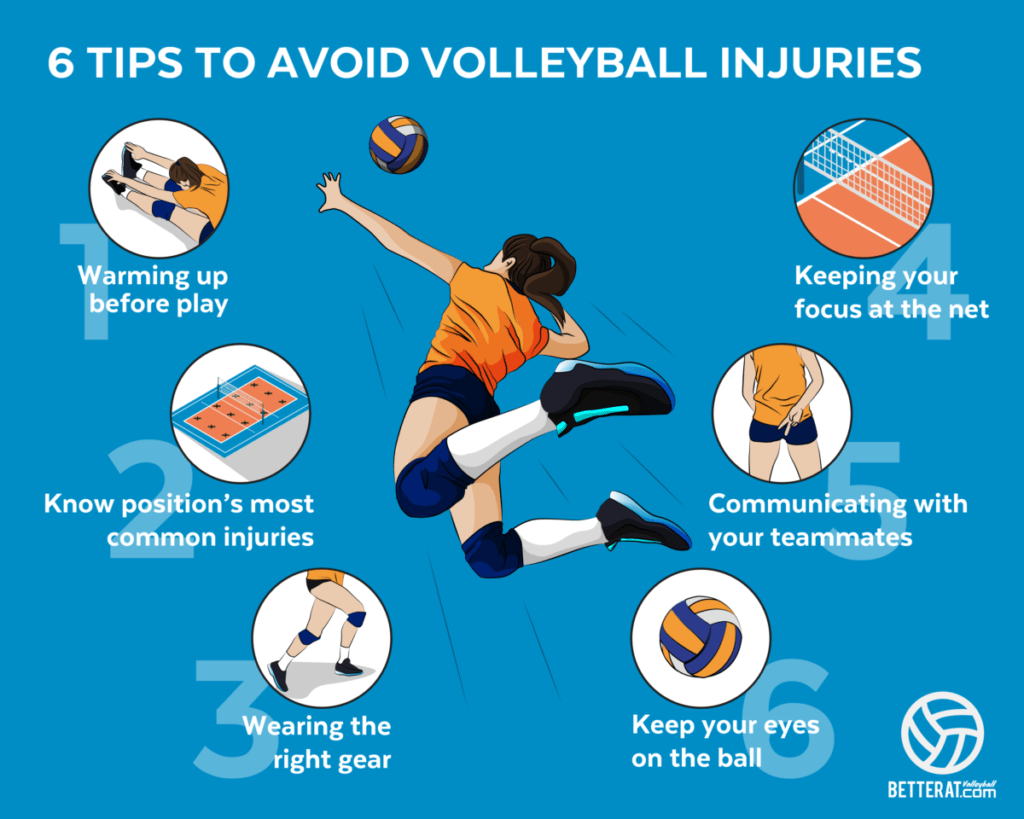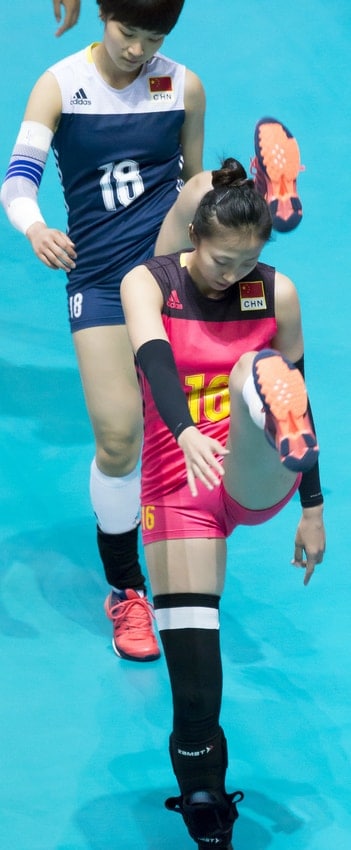Volleyball is one of the safest sports to play, but accidents can still happen that can result in injuries. According to a 2004 study by the British Journal of Sports Medicine, the injury rate was 2.6 injuries for every 1000 hours played, which is really quite low. The most common acute injuries are from ankle sprains and the most common overuse injuries affect the back and shoulder areas.
This article is all about thinking ahead and forming good habits that will help you play and train safely. You want to be able to play hard and compete at your highest level, but also take care of yourself.

Warming Up Before Play
Warming up before play is absolutely critical in preventing injuries because it prepares your body and mind for what you’re about to do. Players should use dynamic warm-ups to get the blood flowing and moving any stiff muscles and joints.

It’s standard practice for your team to have time to warm up before the game, but don’t feel like you have to wait to do it on the court. You can begin loosening up, going through volleyball-type motions before you take the floor.
Since we know that most acute injuries involve ankle sprains, make it a focal point, to warm up your lower legs, stretching your calves and ankles. A good example of this is to do a lap or two of the court making slow lunge steps to gradually loosen up all areas of your legs. While you may still twist an ankle during the game, you’re trying to give your body the best possible chance to handle that without injury.
Since we also know that your back and shoulders are areas that are the most likely to suffer from overuse, make sure to warm up and stretch those areas cautiously. We want them to be loose, but we don’t want to increase the wear and tear needlessly with endless repetitions.
A side benefit to warming up is that you can have time to get your head in the game. Players are often taught to visualize what they’ll be doing during the game in a strategic way – thinking about how they’re going to score or pass. While this can be helpful, don’t overlook your ability to also use visualization to help prevent injury. Visualize and practice your most frequent and your most risky moves – like your hitting approach – in slow motion to warm up with good technique.
Knowing Your Position’s Most Common Injuries
Wouldn’t it be helpful to know which injuries are the most common for your particular position? Fortunately, Dr. Kevin Eerkes published a study in 2012 in Current Sports Medicine Reports where he shared a chart with exactly that kind of break-down.
I’ve reproduced it here:
| Position | Function | Injuries |
| Setter | Set the ball to hitters | Wrist tendinitis Finger injuries |
| Hitter | Hit the ball into the opposing court | Ankle sprains Shoulder instability/ impingement Spondylolysis Patellar tendinitis |
| Server | Serve the ball | Shoulder instability/ impingement |
| Blocker | Block or alter ball hit by the opponent | Finger injuries Ankle sprains Patellar tendinitis |
| Passer | Receive the serve Pass the ball to the setter Dive or dig the ball | Contusions Upper extremity injuries De Quervain Tenosynovitis Lower Back Pain |
Knowing the most common injuries for your specific role can make you aware and may help you know when it’s time to seek medical attention.
If you would like to read more about what Dr. Eerkes has to say about each of these, you can click this link to his study.
Wearing the Right Gear
While ankles, backs, and shoulders take the brunt of the injuries in volleyball, part of the reason for that is because most players have been taught to wear the basic safety equipment that will prevent other injuries.
Here are some of the equipment you’ll see volleyball players wear and why you may want to use them:
Knee Pads – this is the most common and many leagues require players to wear them to get on the court. While players should learn to limit how often they’re hitting their knees to save a ball, wearing knee pads certainly protect your knees from the brunt of the impact when you do have to take your play to the floor.
If you would like to see our recommendations for things like knee pads and elbow pads, check out our player equipment page.
Elbow Pads and Arm Sleeves – arm protection is becoming more and more common in today’s volleyball world. Elbow pads are similar to knee pads and are designed to decrease the impact when you land on the elbow or arm. Sleeves are more about protecting the underside of your forearms from the impact of the ball while returning serve or digging hits.
Braces – players with previous injuries may wear ankle or knee braces to support the joints to try to prevent repeat injuries. Your doctor and trainer can recommend the best braces for your particular situation.
Athletic Tape – this one might surprise you, but athletic tape has become more and more common in sports today. Tape is incredibly versatile and can be used to support all different joints or muscles to reduce strain and try to counter the effects of overuse injuries.
Goggles – while it’s legal to wear glasses, prescription goggles are much safer to wear. If you prefer not to wear contacts, this is your best option. Taking a ball to the face while wearing glasses is just an unnecessary risk – to both your glasses and your face!
Sunglasses – if you play sand volleyball, you should always have a pair on hand. Sunglasses perform two important functions: reducing how much sand you will get in the eyes while diving, and blocking the sun which helps your vision to be able to react to your opponent and play the ball properly.
Would you like to shop for our favorite recommended player products? Choose the item below and click to shop on Amazon.
Keeping Your Focus At The Net
Many injuries happen when you’re competing at the net. You need to stay alert to both what your teammates and your opponents are doing.
As you and your fellow defenders are trying to block and cover it’s pretty easy to get in each other’s way. It helps when your team practices defending and coverage motions at high speed so you can get used to spacing and timing to work together.
When you compete above the net, remember you have to come down and you don’t want to land on your opponent’s feet. While it’s not illegal to step on the centerline, it can turn out to be unfortunate if the foot of your opponent is already there ready and waiting.
This area of the court – the attack zone – is where the majority of the ankles will get rolled and sprained. While you don’t want to be playing scared, you should play aware and alert.
Communicating With Your Teammates
While this follows a similar pattern with keeping your focus while you’re at the net, communication everywhere on the court is helpful in preventing collisions.

One of the most common collisions comes from when no one calls the ball while defending a hard-driven attack and two players clash while both trying to make the play. The other happens when the ball is high in the air and two or more players are looking up, focused on the ball, and collide in the process.
By getting in the habit of calling the ball early and often, you’re helping your team to keep these situations from happening.
Keeping Your Eye On the Ball
Throughout all kinds of sports, this common saying is taught to players for a variety of reasons. Whether it’s a baseball player that’s up to bat or a receiver trying to catch the football, players hear this phrase over and over.
In volleyball, this really makes the most sense while playing defense. Whether it’s during serve-receive or receiving an attack, you need to keep your focus on the ball and whoever is making a play on it.
I’ve watched countless players get struck to the head, who appeared to be looking in the general direction of the ball, but must have been thinking the ball was going to someone else. A great rule of thumb is to always expect the ball (to come to you) until you see otherwise.
If you’ve never seen it, let me assure you, you can get a concussion in volleyball if you take a ball to the head without reacting before the impact. Usually, the player simply didn’t expect the ball and wasn’t really focused on it. By keeping your eye on the ball you’ll be able to at least begin to move in a way that will reduce the impact and protect yourself.
If you would like to learn more about reading your opponent’s attacks, visit this post on digging.
Regardless of what sport you play, the possibility of injury is always there. Hopefully, since you’ve taken the time to read through and think about these tips you’ll be better equipped to prevent these for you or the players around you.
References:
Verhagen EALM, Van der Beek AJ, Bouter LM, et alA one season prospective cohort study of volleyball injuriesBritish Journal of Sports Medicine 2004;38:477-481.
https://bjsm.bmj.com/content/38/4/477.short
Eerkes, Kevin MD Volleyball Injuries, Current Sports Medicine Reports: September/October 2012 – Volume 11 – Issue 5 – p 251-256 doi: 10.1249/JSR.0b013e3182699037
https://journals.lww.com/acsm-csmr/Fulltext/2012/09000/Volleyball_Injuries.10.aspx
Photo Credits:
Feature image by K.M. Klemencic on flickr.com: https://creativecommons.org/licenses/by/2.0/
Warm-ups image by Jeffrey Ng on flickr.com: https://creativecommons.org/licenses/by-sa/2.0/
Communication image by K.M. Klemencic on flickr.com: https://creativecommons.org/licenses/by/2.0/
Recent Posts
Athletes, listen up! Do you have a closet full of old jerseys, sweatpants, and tees that you just can't seem to part with? Well, dust them off, because you're sitting on a goldmine of fashion...
You may have heard, or you may have noticed, that there's been a change to the rule about double contact in volleyball. In 2022, an experimental rule change began to be implemented, where the double...
